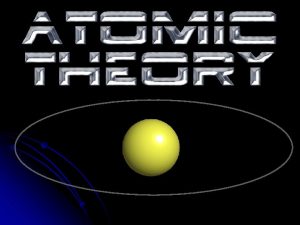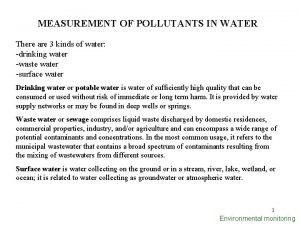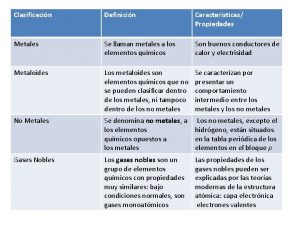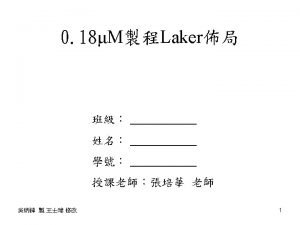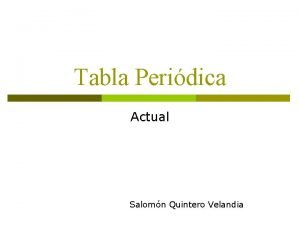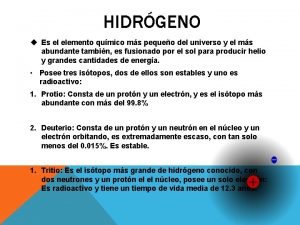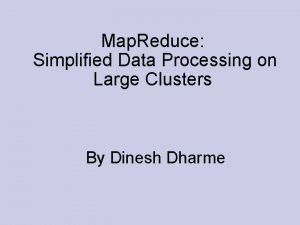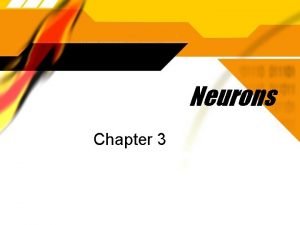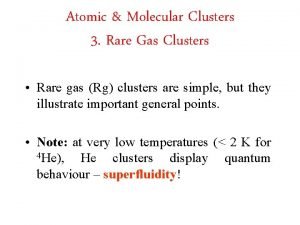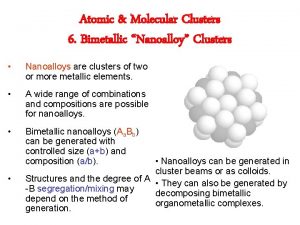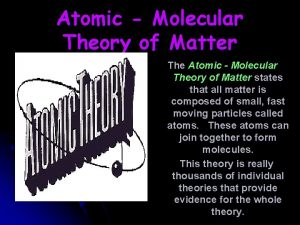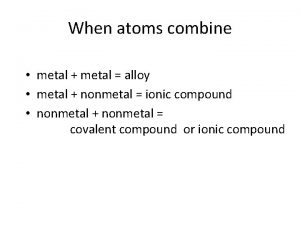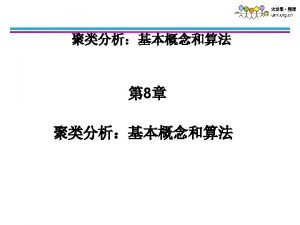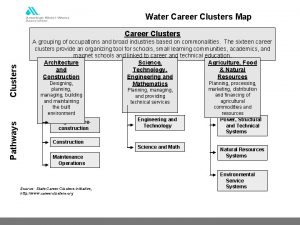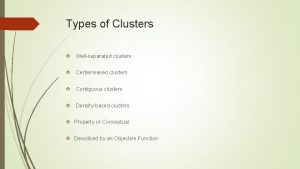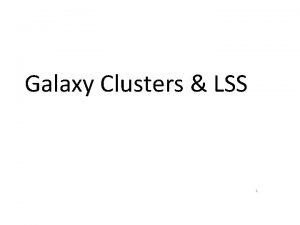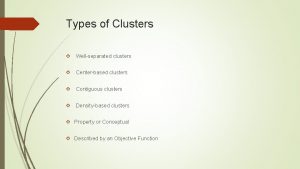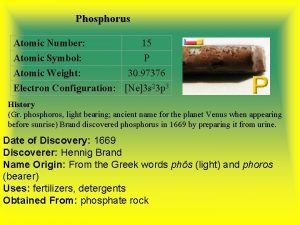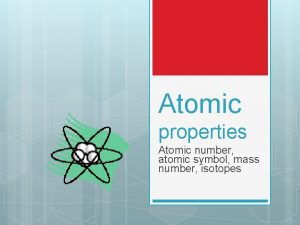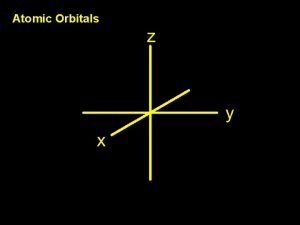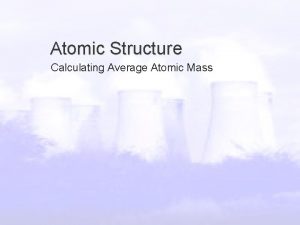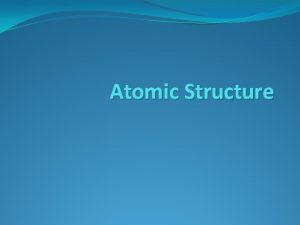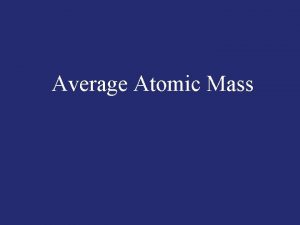Atomic Molecular Clusters 5 Metal Clusters Metal clusters































- Slides: 31

Atomic & Molecular Clusters 5. Metal Clusters • Metal clusters have been widely studied – especially alkali metals, noble metals (Cu, Ag, Au) and transition metals. • Cohesive energies are generally quite large (relatively strong metallic bonding) – significantly higher than for rare gas or molecular clusters – so they may be studied in solution (colloidal suspensions), on surfaces or in inert matrices, as well as in the gas phase. • A number of models have been introduced to explain and predict the properties of metal clusters.

The Liquid Drop Model • • A classical electrostatic model. Cluster is approximated by a uniform conducting sphere. Atomic positions and internal electronic structure ignored. Predictions: Energy IP W As 1/R 0 (N ) {IP, EA} W EA 1/R

{IP(R) W} / e. V {W EA(R)} / e. V M. M. Kappes Chem. Rev. 1988, 369. 1/R / Å

Failures of the Liquid Drop Model • Deviations from 1/R dependence of IPs and EAs for small clusters. • IPs of Hg clusters show a discontinuity due to a sizedependent non-metal transition (see later). • Some transition metals (where ionization involves removal of tightly bound d electrons, e. g. Fe, Ni) show small variation of IP/EA with size. • Magnetic effects (spin-spin interactions) also important for transition metals. • LDM does not reproduce fine structure in IP/EA variation with N (e. g. “even-odd alternation”) or explain the Magic Numbers in the mass spectra. • Require a Quantum Mechanical model with discrete electronic states JELLIUM MODEL.

Mass Spectra and Magic Numbers • Mass spectra obtained by Knight and co-workers (1983 -85), for alkali metal clusters, showed a number of peaks with high relative intensities Magic Numbers. • Magic numbers (and origins) different from rare gas clusters.

The Jellium Model • Derived from nuclear structure theory. • Cluster approximated by a sphere with a uniform positively charged background, filled with an “electron gas” (valence electrons). • Valence electrons are delocalized – move in a smooth, attractive, central, mean field potential of spherical symmetry.

• Positions of ionic cores are ignored. • This is justified if: – electrons are strongly delocalized – ionic background easily deformed – molten clusters? • Works best for monovalent simple metals – e. g. alkali metals, noble metals (Cu, Ag, Au). • Unlike the LDM, the jellium model is a quantum mechanical model – quantization of electron energy levels due to boundary conditions imposed by the potential. • Gives rise to electronic shell structure for metal clusters with up to several 1000 s of atoms.

Empirical Jellium Models • Based on effective single-particle potentials (Knight, Clemenger). • Solve 1 -electron Schrödinger Equation for an electron in a sphere, under the influence of an attractive central potential. • Wavefunction ( ) is separable into radial and angular parts: n, , m (r, , ) = Rn, (r). Y , m ( , )

Solutions • Wavefunction and energies depend on quantum numbers: n = 1, 2, 3, … = 0, 1, 2, … m = … 0 … + (no restriction on ) (2 + 1)-degenerate • Note: the principal quantum number n is different from that used for atomic orbitals (follows convention of nuclear physics): nclust = natom - • Jellium electronic levels (sets of degenerate orbitals) are labelled, by analogy with atomic orbitals: 1 s, 1 p, …, 2 s, 2 p … • Exact ordering of orbitals depends on the radial form of the potential.

The Woods-Saxon Potential • Obtained by fitting to high-level electronic structure calculations. U 0 = E F + W R 0 = Ratom. N 1/3 • W-S potential is a finite well with rounded sides (intermediate between 3 -D harmonic oscillator and 3 -D square well).

• Ordering of Levels: 1 s < 1 p < 1 d < 2 s < 1 f < 2 p < 1 g … • Level Closings (no. of electrons) 2 8 18 20 34 40 58 … 58 40 34 20 18 8 2

Interpreting Mass Spectra of Metal Clusters 1. Low Energy Ionization MN h MN + + e • Magic numbers (intense peaks in MS) due to stable electron counts (filled jellium levels) of neutral clusters (MN). • N* = 8, 20, 40, 58 …

2. High Energy Ionization highly electronically excited MN e high E h MN + + e evaporation of M atoms MX + + (N-X) M • Magic numbers due to stability of cationic clusters (MX+): N* = 9, 21, 41, 59 … • Note: Na 8, Na 9+ both have 8 electrons.

Breakdown of the Spherical Jellium Model • Fine structure is observed in the MS, IPs, EAs, polarizabilities etc. , for even-electron counts other than those predicted by the (spherical) jellium model. • This is evidence for non-degenerate electronic sub-levels, which cannot be explained by the spherical jellium model. • Need to extend the model.

The Ellipsoidal Shell Model • Modification to spherical jellium model, introduced by Clemenger (1985). • Potential = a perturbed 3 -D harmonic oscillator – analogous to Nilsson’s model (1955) for nuclear structure. • Ellipsoidal (“spheroidal”) distortion of cluster. Iz = moment of inertia about z-axis etc.

• Lowering of symmetry loss of (2 +1)-fold degeneracy of each jellium level (n ). • m degeneracy is maintained in ellipsoidal (spheroidal) symmetry. • Oblate Spheroid E as |m | > ½-filled shell • Prolate Spheroid E as |m | < ½-filled shell 1 (np)4 1 =1 (np)2

Variation of Na Cluster Shape with Size

Comparison of structures of Na and Ar clusters

Beyond the Jellium Model • Martin and co-workers (1991)* measured MS of Na. N clusters (N 25, 000). • Observed two series of periodic intensity variations: period N 1/3 * T. P. Martin et al. , J. Phys. Chem. 1991, 95, 6421.

Electronic Shells (N < 2000) • Electronic shells form due to bunching together of jellium levels. • Electronic shells = sets of nearly degenerate jellium levels.

• For larger metal clusters, electronic effects are relatively unimportant because electronic shells merge to form quasi-continuous bands (bulk-like band structure). jellium levels N electronic shells band structure

Geometric Shells (N > 2000) • Geometric shells correspond to complete concentric polyhedral shells of atoms – as for rare gas clusters. • Stability due to minimization of surface energy. • Alkali Metal Clusters – magic numbers are consistent with filling K geometric shells:

Examples of Geometric Shells rhombic dodecahedron (bcc) icosahedron truncated octahedron (fcc)

• Similar magic numbers have been observed for Ca clusters with up to 5000 atoms. * Ca. N+ N • MS magic numbers and fine structure (due to partial geometric shell formation) indicate that alkali metal clusters (with N > 2000) and Ca clusters have icosahedral shell structure. * T. P. Martin Physics Reports 1996, 273, 199.

• Al and In clusters form octahedral shell structures (fragments of fcc packing). In. N+ • Geometric shell structure has also been found for many transition metal clusters (e. g. Co, Ni). • Electronic shell effects are relatively unimportant for TMs with unfilled d-orbitals as the onset of band structure occurs for quite low N.

Microscopy Studies of Metal Clusters • A number of microscopy techniques can be applied to study metal clusters: – Electron Microscopy (TEM, SEM) – Scanning Tunnelling Microscopy (STM) – Atomic Force Microscopy (AFM) • Clusters must be immobilized on a substrate (e. g. graphite, amorphous-C, Mg. O, Si. O 2 – depending on the type of measurement). • Clusters are often passivated by surfactant (ligand) molecules. • Cluster-surface and cluster-ligand interaction may affect cluster structure (for small clusters).

Electron Micrographs of Ag and Au Particles 15 nm 4 nm Single Ag decahedron Multiply-twinned Ag fcc particle 3 nm 7 nm Intergrowth of 2 Au icosahedra Truncated octahedral Au fcc particle Marks decahedral Au particle

Energetics of pure Ag clusters Mackay Icosahedra Quasi-spherical shape. Close-packed surface but strong internal strain. Maximizes the number of NN bonds favourable at small sizes Marks Decahedra Intermediate behaviour. Favourable at Intermediate sizes Fcc Polyhedra Non-spherical shape but no internal strain. Fewer NN bonds. Favourable at large sizes

Insulator-Metal Transition in Hg Clusters • Rademann and Hensel (1987) measured IPs of Hg clusters as a function of size, N. • Explained in terms of a gradual transition: Insulating Semi-Conducting Metallic in the region N ~ 13 -70. • Consistent with spectroscopy and theoretical calculations.

Theory of Bonding in Hg Clusters • The free Hg atom has a closed shell: (6 s)2(6 p)0 – Small clusters are insulating “van der Waals clusters” – held together by dispersion forces. • As the cluster gets larger, the 6 s and 6 p levels broaden into bands (with widths Ws and Wp) – W as N • Insulator Metal Transition occurs when the 6 s and 6 p bands overlap. • Before band overlap (intermediate N), the band gap ( sp) may be comparable to thermal energy (k. T) – semi-conductor clusters – s-p hybridization occurs covalent bonding

Size-dependent Electronic Structures of Hg Clusters
 Zinc oxide + nitric acid → zinc nitrate + water
Zinc oxide + nitric acid → zinc nitrate + water Physical state of covalent compounds
Physical state of covalent compounds Ionic covalent metallic
Ionic covalent metallic Molecular element
Molecular element Atomic molecular theory
Atomic molecular theory Erzeng xue
Erzeng xue How are atomic and molecular orbitals related
How are atomic and molecular orbitals related Difference between atomic and molecular spectroscopy
Difference between atomic and molecular spectroscopy Periodic trends in the modern periodic table
Periodic trends in the modern periodic table Atomic number vs atomic radius
Atomic number vs atomic radius Atom size periodic table
Atom size periodic table Atomic mass of oxygen
Atomic mass of oxygen Relative formula mass of hcl
Relative formula mass of hcl Distinguish between mass number and atomic mass.
Distinguish between mass number and atomic mass. Transition metal with 51 neutrons
Transition metal with 51 neutrons Periodic table pure substances
Periodic table pure substances Características de los metales y no metales
Características de los metales y no metales Difference between metal oxides and non metal oxides
Difference between metal oxides and non metal oxides When a metal reacts with a nonmetal the metal will
When a metal reacts with a nonmetal the metal will Venn diagram of liquid and gas
Venn diagram of liquid and gas Example of metals
Example of metals Metal 1 metal 2
Metal 1 metal 2 Periodo y grupo
Periodo y grupo Physical properties of metals
Physical properties of metals Existen tres isotopos naturales del potasio 39k 40k y 41k
Existen tres isotopos naturales del potasio 39k 40k y 41k Uses of non-metals
Uses of non-metals Dr terry blanch
Dr terry blanch Acidity trends periodic table
Acidity trends periodic table Mapreduce simplified data processing on large clusters
Mapreduce simplified data processing on large clusters 1. the space between traffic clusters is called a(n)
1. the space between traffic clusters is called a(n) Two almond shaped neural clusters
Two almond shaped neural clusters Enrichment clusters
Enrichment clusters




